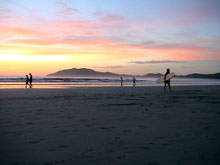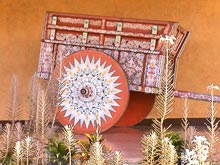The country Costa Rica
Geography
Costa Rica is the second smallest state of Central America behind El Salvador, covering only 19725 square miles. At it's narrowest point Costa Rica is only 119 kilometers wide, at it's widest point the distance between the pacific ocean and the Caribbean coast are 280 kilometers.
The country lays in the tropical climate zone, the yearly temperature changes and the differences in the length of daylight or nighttime are therefore minimal.
The rainy season lasts from May till November and the dry season from December till April.
Flora
The flora of Costa Rica is extremely versatile, the country is called a biological corridor, the ecological systems from north and south meet here. The elevation of Costa Rica almost goes up to 4000 meters, the Cerro Chirripo is with 3819 meters the highest point of Costa Rica. This is a reason for the numerous different vegetation zones.
12000 plant species grow in Costa Rica, 1200 of those are orchid species and 3000 are different kinds of hardwoods.
Fauna
The fauna of Costa Rica is not less impressive! In this tiny country that only presents 0.001% of the landmass of the earth live 5% of all animal species. The 850 different species of birds encountered in Costa Rica represent a tenth of all bird species. Costa Rica is a paradise for birdwatchers!
Of those 230 kinds of mammals the monkeys are some of the easiest to spot. Almost distinct pumas and jaguars still live in Costa Rica but are not easy to encounter. Reptiles like iguanas, crocodiles and turtles are much easier to discover.
The colorful Bluejeansfrog and the red eyed frog are just two of the 160 amphibians that live in Costa Rica. 1400 of the different species of insects are butterflies.
At the coast it is possible to spot dolphins and whales. The pacific is rich of marlins, tuna and Wahoos the Caribbean of tarpons and snook. Costa Rica is one of the best locations for sport fishing worldwide!
Government and political events
Costa Rica is a Constitutional Republic, meaning that the president is head of state and head of government. Political decisions and events in Costa Rica generated a lot of sympathy for this small country. In 1949 Costa Rica got rid of the military and in 1969 the first law for the protection of the environment was decreed. 1987 president Oscar Arias Sanchez won the noble piece price.
Economy
Export good of Costa Rica include: coffee, sugar cane, pineapple, banana, ornamental plants and cut flowers. Especially the dry areas of Guanacaste are used for cattle breeding.
Further export products are textiles and computer parts. One of the most important economic factors is the tourism. At the moment Costa Rica has two international airports, Juan Santamaria Airport near San Jose and Daniel Obeoduber Airport next to Liberia. A further international airport in the south of the country is planned.
Population
The biggest part of the population, whom call themselves ticos, are descendents of the Spaniards. The black population that came from Africa and Caribbean islands lives mostly on the Caribbean coast of Costa Rica. A minority of Chinese, that came to construct the railroad, has settled down allover the country. The Indian natives live mostly in remote reservation areas.
Religion and language
The Catholicism is the most popular religion in Costa Rica followed by minorities like: Jews, Rastafarians and Buddhists.
The official language is Spanish, on the Caribbean coast the people speak the Jamaican form of Patois. Only a few people still speak the native Indian languages. Some of the younger generation of Costa Ricans speak English, especially in tourist areas.
Art and culture
Art treasures from the pre-Columbian time are exhibited at the jade museum, the gold museum and the national museum. Modern and temporary art can be seen in the museum for modern art in Sabana Park which also has a sculpture garden. Well know are the hand painted oxcarts from Sarchi. In the past the carts were used to transport the coffee, nowadays the carts are not used by many people anymore.
Architectonic highlights are the churches in Orosi and Ujarssa and the National Theater in San Jose. Furthermore the white adobe houses in Liberia out of the colonial time.
The National Symphony Orchestra of Costa Rica was formed in 1970. Ballet, Operas and concerts performed on a regularly basis in the National Theater.
The most popular dances in Costa Rica are Salsa, Merengue, Cumbia and Reggaeton. On the Caribbean side the people often party to Reggae tunes. The Ticos are good dancers and nobody feels too old or too jung to dance.
Costa Rica is a wonderful multisided country with a tolerant and hospitable population! A beautiful pace to make holidays or to live in.
Facts about Costa Rica
- Costa Rica stretches over 19725 square miles.
- The Cerro Chirripo is, with 3819 meters, the highest point of Costa Rica.
- 5% of all animal species and 10% of all Bird species can be found in Costa Rica.
- San Jose is the capital of Costa Rica.
- The Costaricans call themselves Ticos.




